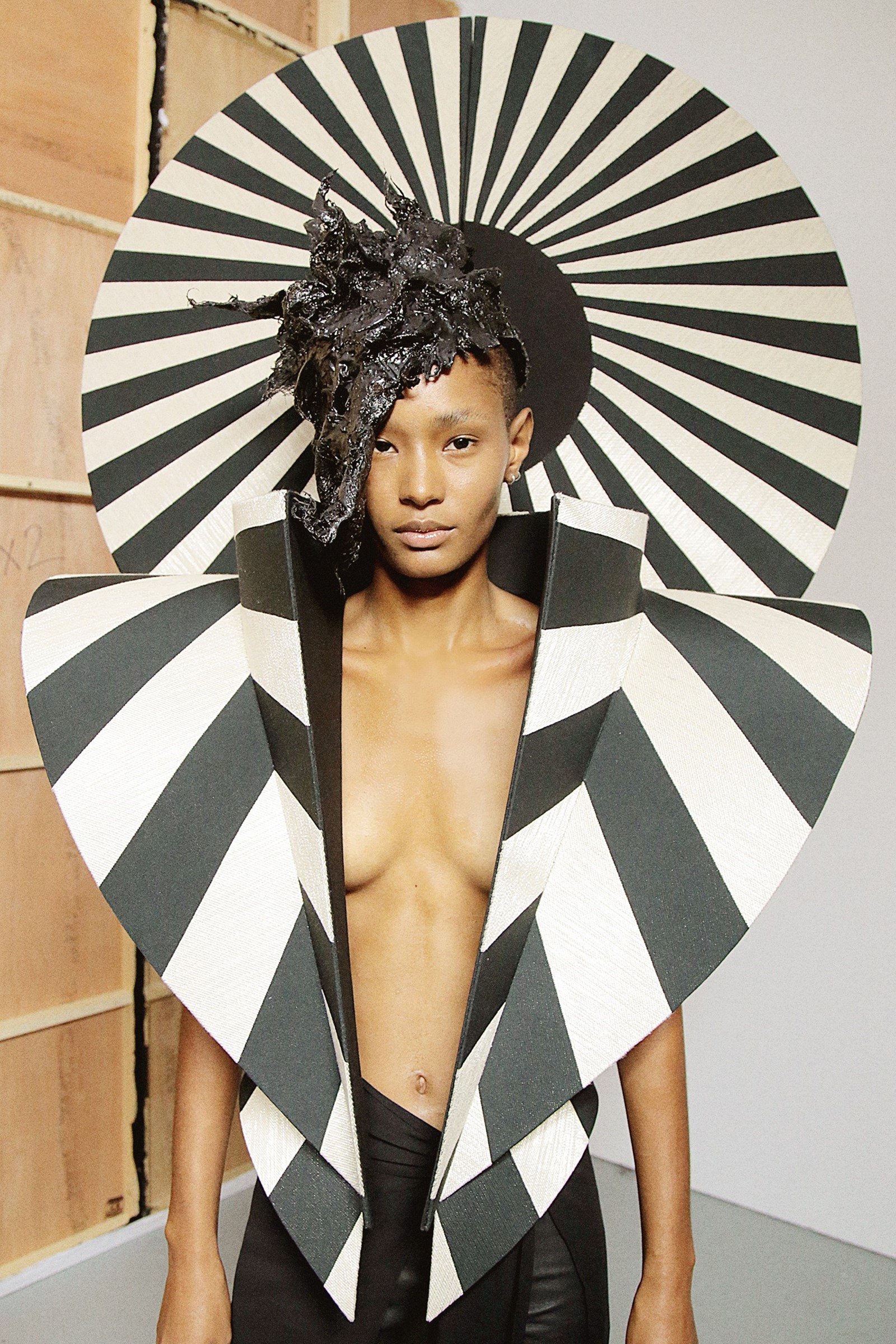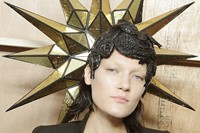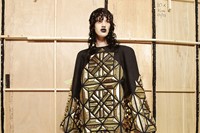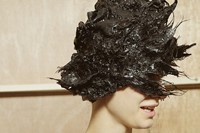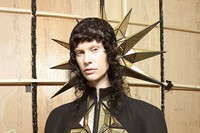The world appears to be in a remarkably precarious situation right now – in fact, so extreme has our devotion to false idols become that we have ended up with a trumped-up reality star running for president. We seem to be experiencing the cultural phenomenon of artifice in its most terrifying form but, while last season’s Gareth Pugh collection explicitly documented the sinister side of the contemporary climate, S/S17 was a triumphant celebration of authenticity. Staged the day after the opening of opera Eliogabalo at the Palais Garnier, for which Pugh designed the costumes and which thus directly inspired the collection, there was an essential purity to it all; while the precise tailoring and structured corsetry most typically associated with Pugh’s aesthetic played an integral role, there was also floating silk chiffon and remarkably natural fabrics (even the appearance of a couple of kaftans). While the show could simply have appeared a harsh condemnation of excess, or a dark reflection of the current political landscape, there was a determined grace and fluidity to what Pugh presented that served as a beacon of creative optimism: an active alternative to the moping it's so easy to settle into.
A Decadent Implosion
A brief primer for those not already versed in operatic narrative: Eliogabalo is a 17th-Century libretto that documents the life of the eponymous Roman emperor. Eliogabalo himself was a child emperor renowned for his appallingly lascivious behavior – think, orgies, opulence and religious scandals – but whose decadent reign operated as a sort of palate cleanser within Roman politics: while things were getting increasingly chaotic even before his ascension to the throne, after his assassination order was restored. Despite the fact that the opera was scheduled to run at the Palais Garnier over four years ago, its story feels particularly prescient – “it’s essentially about an empire eating itself,” Pugh said – and, earlier this year, he was enlisted to design 60 costumes for it. There are few designers better suited than he to embrace the theatricality of the stage, and few occasions in recent history when such a story would feel so quite so relevant but, he laughed, “sometimes the planets align.”
The opening of the show bore a direct parity to the pieces that had debuted the previous evening – there were floating black orbs suspended above thrones to represent the insatiability of greed, splendid stiff tunics decorated with fractured, shimmering appliqué – but then, something shifted. It was as though we were arriving at the end of the story, as if Eliogabalo’s reign had crescendoed into chaos right at the start and, from its ashes, something more elemental emerged. The austere silhouettes of the opening looks gave way to feminine Grecian dresses that danced around the body and left trails of floating fabric in their wake; sharply-cut shattered bullion was replaced by patterned sunbursts and silver-threaded raffia. By the close of the show, that same orb that was previously “the ultimate symbol of insatiable hunger and consumption” was transformed into something determinedly energetic and, rather than succumbing to the horror that can engulf us, the show infused positivity into its audience.

Optimism as Cultural Rebellion
However, that wasn’t always the case – in fact, only a couple of weeks previous, the show had almost been flipped on its head and opulence was to descend into darkness but “it just didn’t seem right,” said Pugh. “We didn’t want it to be heavy, to be pessimistic – but we wanted the girls to look quite tough, quite hard, as if they were fighting for something.” And they did: despite their raffia shift dresses, they wore thick-laced bovver boots, and while some girls might have been swaddled in almost ecclesiastical robes, as Pugh put it “you wouldn’t fuck with them.” This sentiment, of powerful optimism, is one that was directly referenced by the T-shirt Pugh wore at the close of the show: it was printed with Matthew Stone’s slogan “optimism as cultural rebellion.” Stone has been a long-time collaborator of Pugh, and his most recent artistic offering imagined a utopic universe of creative togetherness, writing in his manifesto Everything is Possible and Love Changes Everything that “if all artists reject optimism, then nobody will be here to create the future with sensitivity. The stories will be told, and with conviction, but only by those who seek power over beauty.”
Pugh’s collection was distinctly aligned with such a philosophy – a dismissal of “how corruptive power can be” in favour of a more positive, anarchic sentiment. “Politics often has to swing so far one way before it can swing so far the other,” said Pugh backstage, “and this wasn’t all about politics, but it’s all part of a cultural dialogue that means everyone can have an opinion. It baffles me that people aren’t reacting to a situation that is so omnipresent, so it’s nice to have a small voice on it – but this isn’t a rallying call, it’s just a flare. It’s like I’m just in a little dingy and I’m sending my flare up.”

The Power of Beauty
This flare was part of an ongoing conceit of radiance: there were, of course, the graphic sunbursts, “a symbol of creation of warmth, an explosion of power and life” and Eliogabalo himself was a self-proclaimed sun-god, but there was also Val Garland’s remarkable application of make-up which, although clean and pure, appeared to light the models from within. As women walked onto the runway, they had an otherworldly glow; “we wanted it to feel urgent, tense and hypnotic,” she said. “It was like freedom fighter meets eco-warrior – if it was a movie, it’d be the new Mad Max,” said hair stylist Malcolm Edwards, “like, even though the hair was really nasty, it was polished.” That’s precisely what Pugh achieved here – by applying his renowned, dark refinement to something determinedly luminous, he not only made a fairly fabulous case for anarchic activism but equally propelled his signature aesthetic forwards.
While some of the later silhouettes were simple – the aforementioned kaftans, the A-Line shift dresses – they were perfectly executed and resoundingly contemporary. “Working with the Palais Garnier, I wanted to bring a touch of modernity into a revered place,” he said – and it was clear that working within the confines of operatic rigour (corsetry becomes slightly trickier when you mustn’t restrict breathing capacity) not only paid off on that stage, but equally on this runway. The world at large has seemed a particularly bleak place recently, and while it would have been easy for Pugh to take the concept of Eliogabalo as a starting point for something destructive and ominous, he pushed himself into the realm of creation. Rather than simply condemning artifice, Pugh presented an elemental alternative, a celebration of innate beauty and organic warmth that wasn’t necessarily to be expected of him. There was a refreshing power in such an approach – one that could, and should, pervade far beyond the runway.
